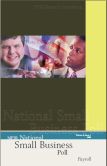Payroll
• Seventy-two (72) percent of small-business employees work full-time. Forty-five (45) percent of small-business owners pay their full-time employees weekly; 26 percent pay them every other week; 13 percent, twice a month; 6 percent, monthly; and, the remainder at other intervals or differing intervals for different full-time employees.
• Ninety (90) percent pay their part-time employees at the same time that they pay their full-time employees.
• Most small employers (64%) prepare payroll in-house. However, 19 percent use a payroll services company and another 14 percent hire an outside accountant or bookkeeper to prepare theirs. Those with the smallest enterprises are most likely to do payroll in-house and those with the largest to send it out. Even then, half of the largest, those businesses employing 20 or more, do payroll in-house.
• The owner/manager is the person who most often (55%) does payroll when it is prepared in-house. An employee does it in 29 percent of cases and an unpaid spouse or family member in 14 percent.
• Only 62 percent of those doing payroll in-house use an electronic spreadsheet of some kind to calculate payroll; 33 percent have their payroll system electronically tied to their accounting software. Size-of-business is highly associated with a computerized payroll system.
• The most common reason given (37%) for doing payroll in-house is that it is the cheapest way. Owners of the smallest are disproportionately likely to mention this reason. Another 32 percent say keeping payroll in-house gives them greater control and better oversight.
• The data to prepare payroll is often sent to vendors on paper rather than electronically. About half who use an outside accountant or bookkeeper submit their payroll records on paper. One in four who use a payroll services company submit theirs on paper.
• The most frequently cited reason for using a payroll service company is that it takes care of everything; it is comprehensive (45%). Other common reasons include: the most effective way to do payroll (17%), allows smoother work flow for in-house personnel (14%), and yields fewer mistakes or errors (11%).
• Forty-two (42) percent report deposit federal payroll taxes quarterly, 27 percent monthly, and 13 percent more frequently.
• Twenty-six (26) percent offer their employees an option to deposit their payroll checks directly into a checking or savings account. Fifty-seven (57) percent of employees in those firms take advantage of the option.
• Sixty-three (63) percent of small employers who have direct deposit for employees say it has been generally helpful to the business compared to only 1 percent who consider it a hassle. The principal reason for having or not having direct deposit is employee interest or lack thereof.
• The W-4 is one of the least burdensome paperwork requirements of the federal government.


